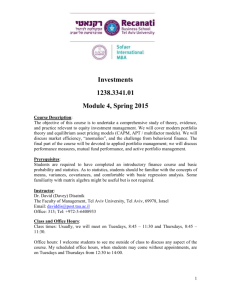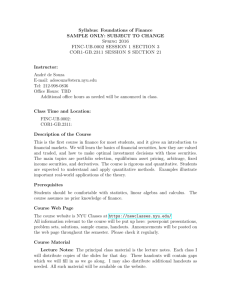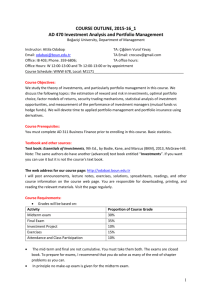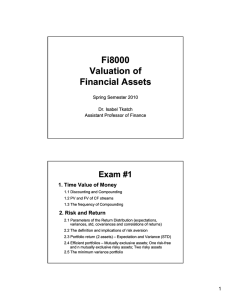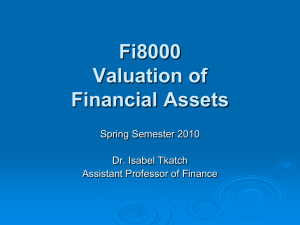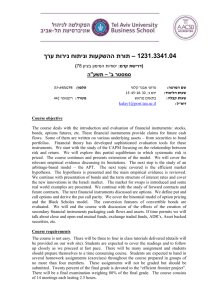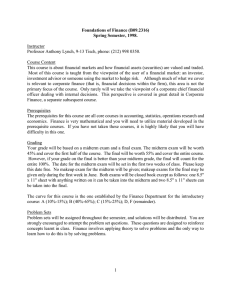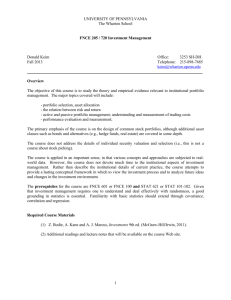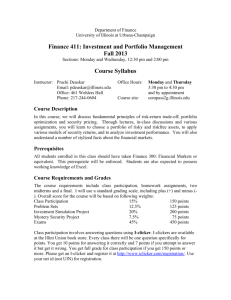Fisher College of Business The Ohio State University Business Finance 4221 Investment Management
advertisement
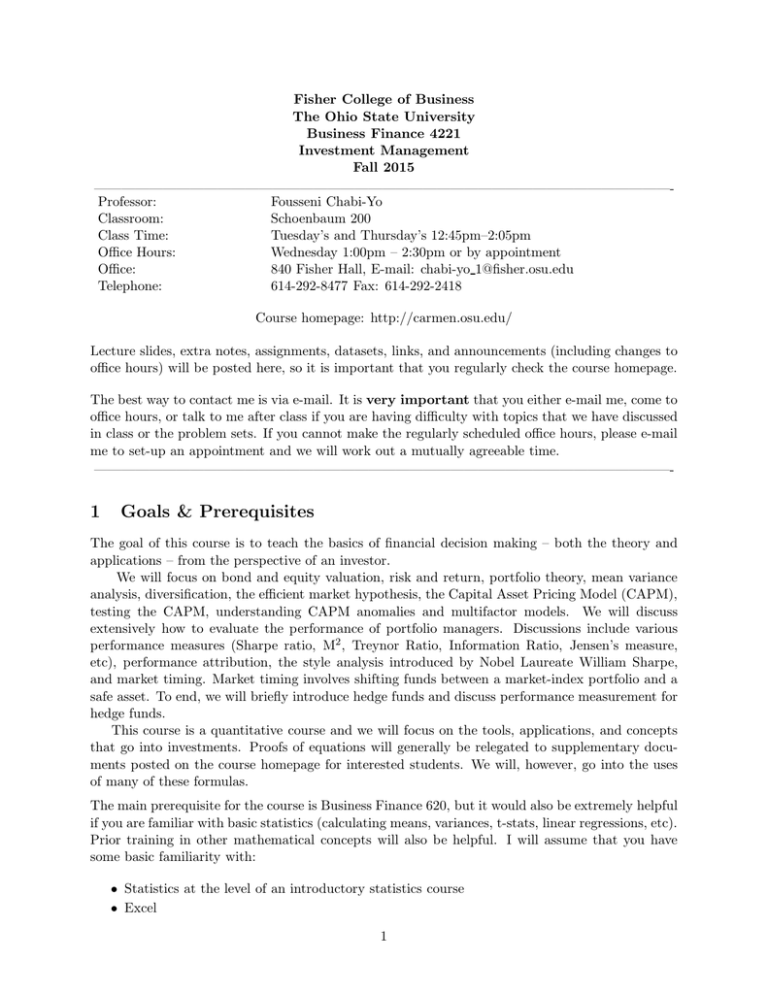
Fisher College of Business The Ohio State University Business Finance 4221 Investment Management Fall 2015 ——————————————————————————————————————————Professor: Fousseni Chabi-Yo Classroom: Schoenbaum 200 Class Time: Tuesday’s and Thursday’s 12:45pm–2:05pm Office Hours: Wednesday 1:00pm – 2:30pm or by appointment Office: 840 Fisher Hall, E-mail: chabi-yo 1@fisher.osu.edu Telephone: 614-292-8477 Fax: 614-292-2418 Course homepage: http://carmen.osu.edu/ Lecture slides, extra notes, assignments, datasets, links, and announcements (including changes to office hours) will be posted here, so it is important that you regularly check the course homepage. The best way to contact me is via e-mail. It is very important that you either e-mail me, come to office hours, or talk to me after class if you are having difficulty with topics that we have discussed in class or the problem sets. If you cannot make the regularly scheduled office hours, please e-mail me to set-up an appointment and we will work out a mutually agreeable time. ——————————————————————————————————————————- 1 Goals & Prerequisites The goal of this course is to teach the basics of financial decision making – both the theory and applications – from the perspective of an investor. We will focus on bond and equity valuation, risk and return, portfolio theory, mean variance analysis, diversification, the efficient market hypothesis, the Capital Asset Pricing Model (CAPM), testing the CAPM, understanding CAPM anomalies and multifactor models. We will discuss extensively how to evaluate the performance of portfolio managers. Discussions include various performance measures (Sharpe ratio, M2 , Treynor Ratio, Information Ratio, Jensen’s measure, etc), performance attribution, the style analysis introduced by Nobel Laureate William Sharpe, and market timing. Market timing involves shifting funds between a market-index portfolio and a safe asset. To end, we will briefly introduce hedge funds and discuss performance measurement for hedge funds. This course is a quantitative course and we will focus on the tools, applications, and concepts that go into investments. Proofs of equations will generally be relegated to supplementary documents posted on the course homepage for interested students. We will, however, go into the uses of many of these formulas. The main prerequisite for the course is Business Finance 620, but it would also be extremely helpful if you are familiar with basic statistics (calculating means, variances, t-stats, linear regressions, etc). Prior training in other mathematical concepts will also be helpful. I will assume that you have some basic familiarity with: • Statistics at the level of an introductory statistics course • Excel 1 • Optimization (the concept, not necessarily how to calculate it by hand) • Present Value • The CAPM If you are unfamiliar with these concepts, it will simply mean a little bit more work for you before class. I will provide notes on the course homepage for some of these concepts. The course will focus largely on classroom lectures and discussions, problem assignments, and a number of empirical exercises. I encourage any constructive feedback throughout the half semester on how the course may be improved. 2 Course Materials • • • • 3 Required Textbook: Essentials of Investments, 9th edition, Bodie, Kane, and Marcus Lecture Slides: to be posted on the course homepage Empirical Homework Assignments: to be posted on the course homepage Articles posted on the course homepage Supplementary Materials The following materials are entirely optional. You might consider some of these materials if you are interested in Investments beyond the scope of the course. • Financial press: Wall Street Journal, Financial Times, Economist • Quantitative Investment Analysis, 2nd edition, DeFusco, McLeavey, Pinto, Runkle, and Anson (A Probability & Statistics-based treatment of Finance) • Financial Modeling, 3rd Edition, Benninga (Excel Modeling for Finance) • Institutional Investment Management, Fabozzi (A somewhat more practitioner-based treatment) 4 Course Evaluation 4.1 Assignments • End of chapter problems: These are meant to test your understanding of the concepts and will help you prepare for exams. These do not need to be handed in and will not count directly towards your grade. • Empirical assignments: These are to be handed in and can be done in groups of up to four students. These are intended to allow you the chance to have hands-on experience with data and also to apply the concepts learned in class. 1. 2. 3. 4. 5. Bond and Equity Valuation Equity Returns Portfolio Choice CAPM Behavioral Finance Comments: – Depending on how we progress through the topics in the course, the assignments may be adjusted. 2 – It is very important that all members of a team contribute to all parts of assignments. • Survey Questions: Near the Final Exam, I will distribute a set of questions to answer. These should be handed in individually and credit will be received for completion. 4.2 Exams There will be two midterms and a final in this course. The midterms and final exams will be closed book, but a formula sheet will be provided. Absences from the midterms and final exams will only be excused for the most serious of (documented) reasons. Please see the section on Policies for more details. The date of the final exam is in the section labeled Schedule & Outline. The final exam is scheduled by the Registrar during the normal finals week. 4.3 Class Participation Class participation will be used in calculating you average. 4.4 Calculating Your Average Empirical Assignments Class Participation Midterm Exam 1 Midterm Exam 2 Final Exam 20% 10% 20% 20% 30% • Late assignments will not be accepted, but your lowest assignment score will be dropped. • The final exam is cumulative. 5 Policies Fairness. I will make every effort to treat students with dignity and fairness and to be sensitive to the diversity that exists within the student body. Students with disabilities who request help will be given reasonable accommodation with the assistance of the University Office of Disability Services (292-3307, http://www.ods.ohio-state.edu/). Please feel free to speak to me in private about any related issues. Academic Misconduct. Students are expected to abide by the Fisher College of Business Honor Code. Among other things, please do not submit plagiarized work or give or receive information during exams and please provide proper acknowledgment in work when applicable. Classroom Conduct. Please silence all cell phones and turn off electronic devices like iPods. Laptops will be permitted in class for note-taking purposes, but please do not distract your classmates by using your laptop to surf the internet or conduct other business during lecture. I also ask that students remain professional and respectful during class discussions. Questions Outside of Class. For any questions that have not been sufficiently answered in class, please e-mail me or come to office hours. If you cannot make the regularly scheduled office hours, please e-mail me and we will try to schedule a mutually agreeable time. 3 Absences from Exams. Absences from exams will only be excused with written documentation from an appropriately accredited professional (i.e. a medical doctor). Exam Regrading. If you feel that there has been a mistake in grading your exam, you can submit your exam to be regraded. All regrade requests should be submitted within a week of when the exam was returned to the class. You should submit your exam along with a brief written explanation of why you believe the exam was graded incorrectly. The whole exam will be regraded and there is a possibility that your overall score will actually decrease as a result of a regrade. 6 Acknowledgments This course draws on materials used by Karl Diether, Reto Gallati, Andrew Karolyi, Jun Pan, Dimitris Papanikolaou, and Lu Zhang in investments classes at both Ohio State and other universities. 7 Schedule & Outline The following schedule is tentative and subject to change based on how the class progresses. Please note that assignment due dates are subject to change. Approximate dates are only included here for planning purposes. Please see the course homepage for updates. 4 Date Topic Reading 08/25 Course Introduction & Overview of Investments Financial Markets Financial Markets (con’t) Equity valuation Introduction to Bond Bonds, Convexity and Immunization BKM Ch. 1 & Ch. 2 Bonds, Convexity and Immunization (con’t) Midterm Review BKM Ch. 11 08/27 09/01 09/03 09/08 09/10 09/15 09/17 09/22 09/24 09/29 10/01 BKM BKM BKM BKM BKM Ch. Ch. Ch. Ch. Ch. Assignment Due Dates 3 & Ch. 4 3 & Ch. 4 13 10 & Ch. 11 11 Assignment #2 Due 10/13 10/15 Midterm Rates of Return Risk & Return Portfolio Choice & Mean-Variance Analysis Portfolio Choice & Mean-Variance Analysis(cont’d) Portfolio Choice & Mean-Variance Analysis(cont’d) The CAPM: Theory The CAPM: Empirical Tests 10/20 10/22 10/27 10/29 11/03 11/05 CAPM Anomalies Multifactor Models Efficient Market Hypothesis Midterm Review Midterm Portfolio Performance Measures BKM Ch. 7 BKM Ch. 7 BKM Ch. 8 11/10 BKM Ch .18 11/26 12/01 Portfolio Performance (con’t) Performance Attribution Analysis Market Timing Behavioral Finance and Analysis Behavioral Finance and Analysis (con’t) Thanksgiving-no classes Introduction to Options 12/03 12/08 Final Exam Review Final Exam Review (con’t) TBD Final Exam TBD 10/06 10/08 11/12 11/17 11/19 11/24 BKM Ch. 5 BKM Ch. 5 BKM Ch. 6 and Style Survey Due BKM Ch. 6 BKM Ch. 6 BKM Ch. 7 BKM Ch. 7 BKM Ch. 18 Measures Assignment #1 Due Technical BKM Ch. 18.2 & BKM Ch. 18.5 BKM Ch. 18.6 BKM Ch. 9 Technical BKM Ch. 9 Assignment #3 Due Assignment #4 Due BKM Ch. 15 & 16 5 Assignment #5 Due
